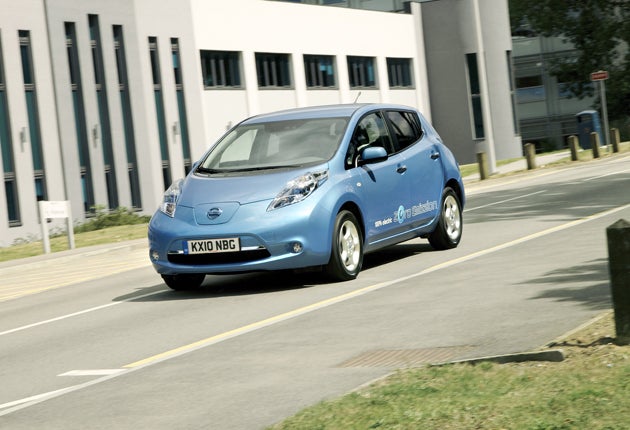Nissan Leaf
Just how far can Nissan's electric car go?

Electric cars really are coming.
There has been much noise about their arrival, but so far just the speedy and expensive Tesla sports car and the ludicrous G-Wiz have actually been seen on the roads. Now the mainstream carmakers' onslaught is about to start, and I have just driven the first manifestation – the Nissan Leaf.
The Leaf is a five-door hatchback, purpose-made for electric propulsion. Its styling is deliberately restrained so that it doesn't frighten buyers away, and its price is just about low enough – once the Government's £5,000 subsidy is included – to make some economic sense.
UK sales start early next year, by which time the VAT rate will be 20 per cent, and the subsidised price will be £23,990. Batteries are included (they have a 10-year life expectancy). Just one very well-equipped version will be offered, and the only option will be a solar panel on the rear spoiler to help charge the 12-volt battery that powers the electrical ancillaries. The first cars will be built in Japan, but Nissan's factory in Sunderland will make them from 2013.
Sounds promising so far. But for all its total lack of emissions (those from electricity production notwithstanding), the freedom from road tax and the minuscule cost of charging it up, any electric car is viable only if it can travel a sensible distance before it needs to be recharged. It's this range that has been the major tripwire to date. Nissan says the Leaf should manage 160km (about 100 miles) on one full charge, enough for a generous daily commute, and after an eight-hour overnight recharge it's ready to do it again.
If your Leaf needs feeding on a longer journey, you can give it a "quick charge" – typically a half-hour blast at 400 volts and 32 amps – which will take the charge back up to 80 per cent, beyond which the high charging rate might damage the lithium-ion battery pack. This assumes you have found a suitable charging point – and in the next few years we'll see a lot of them springing up in shopping centres, service stations, entertainment complexes, municipal car parks and roadside parking bays. The Leaf's sat-nav system shows where they are, constantly updated via the car's own telematics link.
The system can also show, on a map, the radius from your current position that you can travel on the charge you have left. If your destination is inside the circle, you'll probably arrive. Other clever gadgetry lets you set the charging timer remotely by telephone or computer, and pre-warm or pre-cool the cabin the same way.
So, what is the Leaf actually like? Surprisingly normal is the answer, once you have got used to the idea of feeding it electrons via the flap in its nose. Open the bonnet and you'll see what looks like a normal engine, complete with a shiny "camshaft cover" and a circle-and-stripe Nissan badge pretending to be an oil filler cap. The motor produces 109bhp and 207lb/ft of torque, but these healthy outputs have to haul around 1,450kg of Leaf, of which the battery pack, slung low under the floor, accounts for 250kg.
This gives a low centre of gravity, so the Leaf corners confidently and leans little. You can feel that it is a heavy car, but the steering is positive and natural, and the brakes are rather more progressive in their action than regenerative braking systems often are.
Most remarkable of all is the quietness of running, not only from the motor but in the suppression of the wind and road roar that would normally be thrown into prominence by the lack of engine noise. At town speeds there's a gentle whine – electronically synthesised – to warn pedestrians of the Leaf's approach. Acceleration from rest is vigorous, as is the electric way, and motorway cruising is utterly effortless. Top speed is around 90mph.
The whole Leaf idea seems marvellous until you notice the figures displayed on the futuristic-looking dashboard displays. The figure is one to which you could well become glued, because it shows how far you can still drive before a voice urges you to find a charging station.
It showed over 140km as I began my 30km test route, driving keenly but not especially speedily. It included town, country and motorway. A short way round the route for the second time, only 40km of range remained, and that voice made herself heard around 10km from the end. Nissan's Tom Smith, head of Leaf marketing, says the range indicator fluctuates too much and that it will be better in the final production cars. I say there's a serious worry that the Leaf might not travel as far on a full charge as you might reasonably expect.
It's a great idea and potentially a great car. Just make sure you check out the latest intelligence on its real-world range before you buy one.
Subscribe to Independent Premium to bookmark this article
Want to bookmark your favourite articles and stories to read or reference later? Start your Independent Premium subscription today.

Join our commenting forum
Join thought-provoking conversations, follow other Independent readers and see their replies